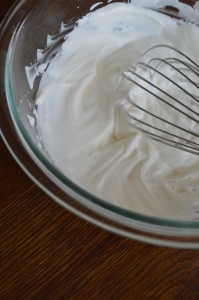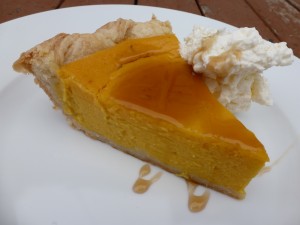Attendez la crème![1]
-Col. Hans Landa
 Though whipped cream has been around for hundreds of years, it took two relatively modern inventions for it to become as common as it is now.
Though whipped cream has been around for hundreds of years, it took two relatively modern inventions for it to become as common as it is now.
One is the wire whisk. Before this tool was invented, cooks used cumbersome bundles of sticks or straw. More important for the future of whipped cream, though, was the invention of the mechanical cream separator. The traditional way to separate cream from milk is to let the fresh milk stand for several hours. Fattier bits will float to the top, and the cream skimmed from the surface will typically be about 25% fat. Mechanical separators use centrifugal forces and are able to produce cream with a much higher fat content, usually around 33%, which requires much less whipping to form a stable foam.[2]
As we discussed in the post on butter, the fat in milk and cream is packed into little globules. If we agitate cream and break the walls of these globules, fat is released into the surrounding water. The agitation also incorporates tiny air bubbles. Since fat and water repel each other, the recently freed fat congregates along the air-bubble walls. Since the cream is cold, the saturated dairy fat is quite stiff, and it forms a stable foam.
There are only a handful of important things to know to make good whipped cream.
Use good, heavy cream that is at least 30% fat. As mentioned above, whipped cream relies on a high fat content to form a stable foam.
Chill the cream and mixing bowl thoroughly. The fat in the cream must absolutely be cold for it to form a stable confection.
Slower whipping incorporates more air before the fat globules are broken, resulting in lighter cream. Whipping by hand generally makes for an airier whipped cream than whipping with a stand mixer.
Don’t over-whip the cream. Even if you whip slightly too long, the texture of the cream will not be smooth and velvety, but slightly grainy and waxy. And if you whip much too long you will make butter.
I typically use a stand mixer to make whipped cream, and I judge doneness by the surface of the cream as the whisk attachment moves through it. As the cream begins to thicken the wires of the whisk will start to leave trails in the dairy. Then the cream will start to bunch up around the trails. Once you see this bunching, the whipped cream is done.
 At right is a picture of pumpkin pie with some cream that has been whipped too much. It is stiff and grainy and sad.
At right is a picture of pumpkin pie with some cream that has been whipped too much. It is stiff and grainy and sad.
The only other ingredients in classic whipped cream are sugar and vanilla. Both can be added to taste. A good guideline for sugar quantity is 10% of the weight of the cream.
Whipped cream flavoured with vanilla is called crème Chantilly in classical French cuisine. The double “l” in French makes an “ee” sound, so Chantilly is correctly pronounced “shan-TEE,” not “shan-TILL-ee”.
That’s everything I know about whipped cream.
Footnotes
- “Wait for the cream!” This is from the movie Inglorious Basterds. A Nazi officer foists an Austrian strudel onto a French girl, and as she prods it with her fork, he politely demands that she wait for the whipped cream to arrive before tasting the pastry. It’s a good scene.
- The info in this paragraph is from McGee’s On Food and Cooking.